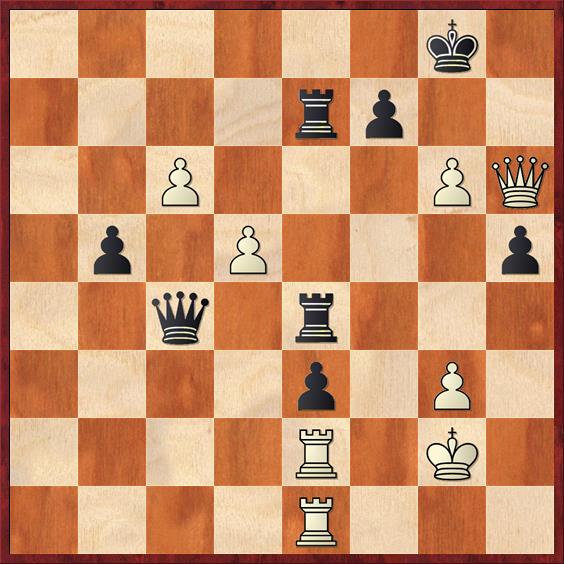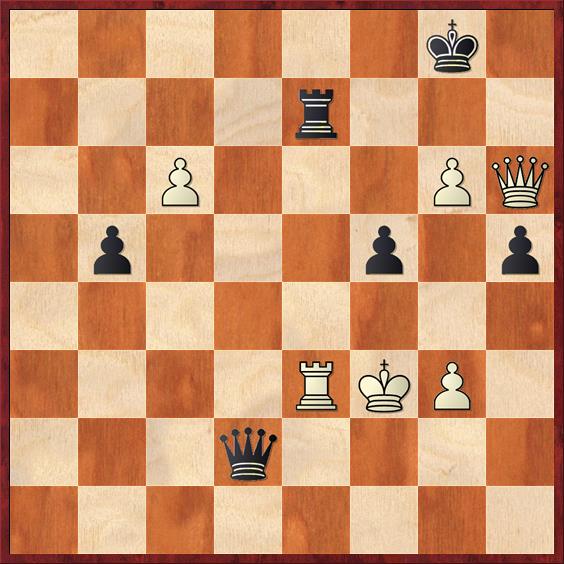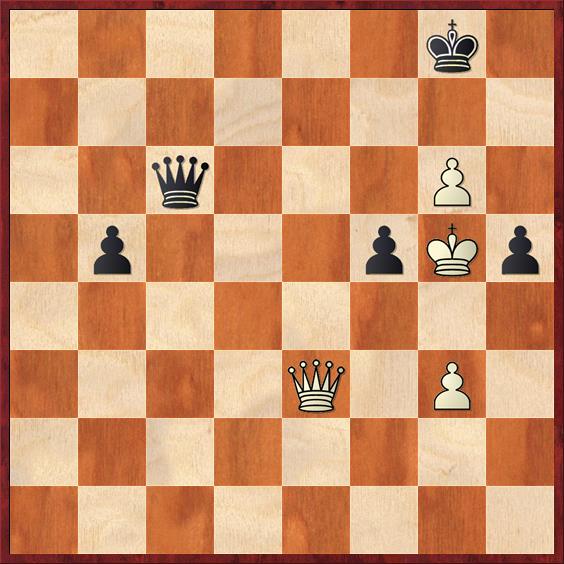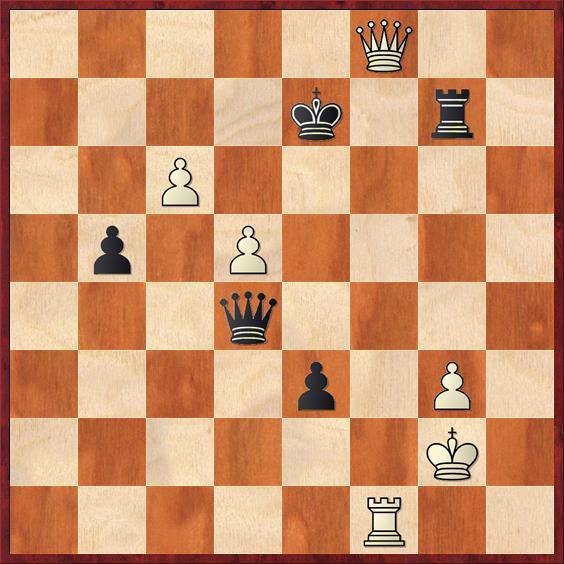In today’s fourth round of the FIDE World Cup, there were two big upsets: #16 Peter Svidler over #1 Veselin Topalov and #19 Shakhriyar Mamedyarov over #3 Fabiano Caruana. Two other games were won by the favorite: #2 Hikaru Nakamura over #16 Michael Adams and #8 Ding Liren over #24 Wei Yi. The other four were drawn.
I tuned in too late to see any of the Mamedyarov game while it was happening. However, I did see the final stages of the Svidler-Topalov game. This was another one where the computers were much more certain what was going on than any of the human grandmasters. It was a wild and woolly position with no minor pieces but all the major pieces still on the board. Here was Topalov’s last chance to save the game:
 Position after 57. g6. Black to move.
Position after 57. g6. Black to move.
FEN: 6k1/4rp2/2P3PQ/1p1P3p/2q1r3/4p1P1/4R1K1/4R3 b – – 0 57
Svidler has just played 57. g6, a nice multipurpose move that (a) threatens mate in two beginning with 58. Qh7+; (b) opens a diagonal so that he can capture on e3; and (c) opens the fifth rank so that he can capture on h5 and at the same time defend his d5 pawn. Even so, Black has a defense. Do you see it?
First I’ll tell you what Topalov did. He almost immediately replied 57. … fg? , the losing move. Sergei Shipov (I was listening to the Russian-language broadcast, having lost patience with the deadly dull English commentary) sharply criticized Topalov, not for the move but for the speed with which he played it. “The time is given to you so that you can use it,” he said. “You don’t have to slap your moves down.” At the time Topalov had 5 minutes for the rest of the game and Svidler had 3 or 4, but of course they also had the 30-second-per-move time increment.
Topalov’s move let Svidler get his dream position: 58. Qxg6+ Rg7 59. Qxh5, holding everything. Now Topalov played 59. … Qd4 and Svidler played 60. Ra2!, getting one of his rooks into the attack. “The game is over,” Shipov said. It ended with a flourish: 60. … Rf4 61. Ra8+ Rf8 62. Rxf8+ Kxf8 63. Qh8+ Kf7 (63. … Ke7 was slightly better but it allows White to win Black’s e-pawn with 64. Rxe3+ Qxe3 65. Qxg7+) 64. Rf1+ and now Topalov surprisingly allowed mate-in-one with 64. … Ke7 65. Qf8 mate.
FEN: 5Q2/4k1r1/2P5/1p1P4/3q4/4p1P1/6K1/5R2 b – – 0 65
I love the economy of this checkmate — every White piece is doing something! Well, except for the king.
To me it looks as if Topalov lost the thread of the game, and it’s the second straight round when he has done that. He drew his first game against Lu Shanglei from a position where he was simply a piece up and Lu had almost no compensation. Topalov explained that blunder by saying that he lost interest in the game. He also, apparently, said in the same interview or another one that he wished he were back home.
Lost interest in the game? Want to go back home? Message to Topalov: Be careful what you wish for! Even if you are joking, you shouldn’t tempt fate like that. If you aren’t mentally prepared for the battle, Caissa will come back and bite you!
Answer to quiz: In the initial position, Black can save himself with 57. … f5! Kind of a neat move, because it cancels out two of the threats White made with his last move. It defends the checks on the seventh rank, and it leaves the d5 pawn unguardable.
However, it does allow White to win the e3-pawn. After 58. Rxe3 Rxe3 59. Rxe3 Black cannot, of course, take on e3 because he gets mated. But he can take on d5: 59. … Qxd5+ 60. Kf2 Qd2+ 61. Kf3 and now we have an extra special bonus quiz!
 Position after 61. Kf3 (analysis). Black to move.
Position after 61. Kf3 (analysis). Black to move.
FEN: 6k1/4r3/2P3PQ/1p3p1p/8/4RKP1/3q4/8 b – – 0 61
Extra special bonus quiz: What is Black’s best continuation? Should he play for a win or play for a draw?
If I had been playing the position as Black, I feel certain that I would have blundered the game. I would have said, “The heck with drawing, I’m playing for a win!” And I would have played 61. … Rxe3+? 62. Qxe3 Qd5+ 63. Kf4 Qxc6 64. Kg5, after which Black seems to have a healthy extra pawn. Looking at this position, I thought that it’s definitely White who is fighting for a draw and Black who has all the winning chances.
 Position after 64. Kg5 (analysis). Black to move.
Position after 64. Kg5 (analysis). Black to move.
FEN: 6k1/8/2q3P1/1p3pKp/8/4Q1P1/8/8 b – – 0 64
Wrong! When I put it on Rybka, it showed White with a 2-pawn advantage. Even though Black is a pawn ahead and White’s passed pawn seems to be securely blockaded, and even thought it’s Black to play. White’s main threat is to play Kh6 and then weasel his queen’s way to the back rank with Qb3+-b2+-a2+-a8 mate, and Black basically has no defense to this plan. He’ll have to run away with his king to f8, but then White is able to shepherd his g-pawn through to the queening square.
Note that Black’s extra pawns are worth nothing. In fact, the h-pawn is a “traitor pawn,” which keeps Black from checking White’s king away when he moves to h6.
So in diagram three, Black should not tempt fate by playing for a win. He should simply play 61. … Qd5+, and after the likely 62. Kf2, repeat the position with 62. … Qd2+. If White plays for a win with 62. Kf4, he likewise gets burned after 62. … Qc4+. (All analysis courtesy of Rybka.) This is why chess is so hard. Most of the time you should try to win, but now and then you have to recognize when a position is too dangerous, and trying too hard to win is in fact the best way to lose.




{ 1 comment… read it below or add one }
In my opinion, queen and rook endings are almost impossible to play accurately in time pressure.
Each player may have 30 possible rook and queen moves available to them on each move, not even considering pawn and king moves. Within just 4 or 5 ply that is almost a million possibilities.
My advice? Avoid these endings.